Spatial-Temporal Pattern Evolution of Xi’an Metropolitan Area Using DMSP/OLS and NPP/VIIRS Nighttime Light Data
Abstract
:1. Introduction
2. Materials and Methods
2.1. Research Area
2.2. Data Introduction
2.2.1. DMSP/OLS Nighttime Light Data
2.2.2. NPP/VIIRS Nighttime Light Data
2.2.3. Auxiliary Data
3. Methodology
3.1. Data Pre-Processing
3.2. Nighttime Light Data Composition
3.2.1. DMSP/OLS Image Correction
3.2.2. NPP/VIIRS Image Correction
3.2.3. Intercalibration of OLS and VIIRS
3.3. City Status Indicators
3.3.1. Nighttime Light Index
3.3.2. Urban Built-Up Area
3.3.3. Urban Sprawl
3.3.4. Center of Gravity
4. Results
4.1. Accuracy Validation with GDP
4.2. Spatial-Temporal Pattern of XMA
4.3. Analysis of Nighttime Light Index
4.4. Built-Up Area Extraction of XMA
4.5. Evolution of Nighttime Light Gravity Center in XMA
5. Discussion
5.1. Natural Environments around XMA
5.2. City Expansion and Development Policy
5.3. Comparisons with Traditional Research
5.4. Shortage and Prospects
6. Conclusions
Author Contributions
Funding
Institutional Review Board Statement
Informed Consent Statement
Data Availability Statement
Acknowledgments
Conflicts of Interest
References
- Chen, M.; Liu, W.; Lu, D. Challenges and the way forward in China’s new-type urbanization. Land Use Policy 2016, 55, 334–339. [Google Scholar] [CrossRef]
- Su, S.; Liu, Z.; Xu, Y.; Li, J.; Pi, J.; Weng, M. China’s megaregion policy: Performance evaluation framework, empirical findings and implications for spatial polycentric governance. Land Use Policy 2017, 63, 1–19. [Google Scholar] [CrossRef]
- Halder, B.; Bandyopadhyay, J. Evaluating the impact of climate change on urban environment using geospatial technologies in the planning area of Bilaspur, India. Environ. Chall. 2021, 5, 100286. [Google Scholar] [CrossRef]
- Liu, F.; Zhang, Z.; Zhao, X.; Wang, X.; Zuo, L.; Wen, Q.; Yi, L.; Xu, J.; Hu, S.; Liu, B. Chinese cropland losses due to urban expansion in the past four decades. Sci. Total Environ. 2019, 650, 847–857. [Google Scholar] [CrossRef]
- Yan, Y.; Wu, C.; Wen, Y. Determining the impacts of climate change and urban expansion on net primary productivity using the spatio-temporal fusion of remote sensing data. Ecol. Indic. 2021, 127, 107737. [Google Scholar] [CrossRef]
- Agarwal, M.; Tandon, A. Modeling of the urban heat island in the form of mesoscale wind and of its effect on air pollution dispersal. Appl. Math. Model. 2010, 34, 2520–2530. [Google Scholar] [CrossRef]
- Bao, C.; He, D. Scenario Modeling of Urbanization Development and Water Scarcity Based on System Dynamics: A Case Study of Beijing-Tianjin-Hebei Urban Agglomeration, China. Int. J. Environ. Res. Public Health 2019, 16, 3834. [Google Scholar] [CrossRef] [Green Version]
- Wang, S.; Gao, S.; Li, S.; Feng, K. Strategizing the relation between urbanization and air pollution: Empirical evidence from global countries. J. Clean. Prod. 2020, 243, 118615. [Google Scholar] [CrossRef]
- Kadhim, N.; Mourshed, M.; Bray, M. Advances in remote sensing applications for urban sustainability. Euro-Mediterr. J. Environ. Integr. 2016, 1, 7. [Google Scholar] [CrossRef] [Green Version]
- Xie, Y.; Weng, Q. Updating urban extents with nighttime light imagery by using an object-based thresholding method. Remote Sens. Environ. 2016, 187, 1–13. [Google Scholar] [CrossRef]
- Pesaresi, M.; Huadong, G.; Blaes, X.; Ehrlich, D.; Ferri, S.; Gueguen, L.; Halkia, M.; Kauffmann, M.; Kemper, T.; Lu, L.; et al. A Global Human Settlement Layer from Optical HR/VHR RS Data: Concept and First Results. IEEE J. Sel. Top. Appl. Earth Obs. Remote Sens. 2013, 6, 2102–2131. [Google Scholar] [CrossRef]
- Cauwels, P.; Pestalozzi, N.; Sornette, D. Dynamics and spatial distribution of global nighttime lights. EPJ Data Sci. 2014, 3, 2. [Google Scholar] [CrossRef] [Green Version]
- Yanhua, X.; Qihao, W.; Anthea, W. A comparative study of NPP-VIIRS and DMSP-OLS nighttime light imagery for derivation of urban demographic metrics. In Proceedings of the 2014 Third International Workshop on Earth Observation and Remote Sensing Applications (EORSA), Changsha, China, 11–14 June 2014; pp. 335–339. [Google Scholar]
- Frolking, S.; Milliman, T.; Seto, K.C.; Friedl, M.A. A global fingerprint of macro-scale changes in urban structure from 1999 to 2009. Environ. Res. Lett. 2013, 8, 024004. [Google Scholar] [CrossRef]
- Sutton, P.; Elvidge, C.; Tilottama, G. Estimation of Gross Domestic Product at Sub-National Scales Using Nighttime Satellite Imagery. Int. J. Ecol. Econ. Stat. 2007, 8, 5–21. [Google Scholar]
- Elvidge, C.; Baugh, K.; Anderson, S.; Sutton, P.; Tilottama, G. The Night Light Development Index (NLDI): A spatially explicit measure of human development from satellite data. Soc. Geogr. 2012, 7, 23–35. [Google Scholar] [CrossRef]
- Xin, X.; Liu, B.; Di, K.; Zhu, Z.; Zhao, Z.; Liu, J.; Yue, Z.; Zhang, G. Monitoring urban expansion using time series of night-time light data: A case study in Wuhan, China. Int. J. Remote Sens. 2017, 38, 6110–6128. [Google Scholar] [CrossRef]
- Chen, J.; Wei, H.; Li, N.; Chen, S.; Qu, W.; Zhang, Y. Exploring the Spatial-Temporal Dynamics of the Yangtze River Delta Urban Agglomeration Based on Night-Time Light Remote Sensing Technology. IEEE J. Sel. Top. Appl. Earth Obs. Remote Sens. 2020, 13, 5369–5383. [Google Scholar] [CrossRef]
- Liu, Z.; He, C.; Zhang, Q.; Huang, Q.; Yang, Y. Extracting the dynamics of urban expansion in China using DMSP-OLS nighttime light data from 1992 to 2008. Landsc. Urban Plan. 2012, 106, 62–72. [Google Scholar] [CrossRef]
- Zhang, Q.; Seto, K.C. Mapping urbanization dynamics at regional and global scales using multi-temporal DMSP/OLS nighttime light data. Remote Sens. Environ. 2011, 115, 2320–2329. [Google Scholar] [CrossRef]
- Niu, W.; Xia, H.; Wang, R.; Pan, L.; Meng, Q.; Qin, Y.; Li, R.; Zhao, X.; Bian, X.; Zhao, W. Research on Large-Scale Urban Shrinkage and Expansion in the Yellow River Affected Area Using Night Light Data. ISPRS Int. J. Geo-Inf. 2021, 10, 5. [Google Scholar] [CrossRef]
- Jaros, K.A. Forging Greater Xi’an: The Political Logic of Metropolitanization. Mod. China 2015, 42, 638–673. [Google Scholar] [CrossRef]
- Dijkstra, L.; Poelman, H.; Veneri, P. The EU-OECD Definition of a Functional Urban Area; OECD Publishing: Berlin, Germany, 2019. [Google Scholar] [CrossRef]
- Wang, Z.F. The Relationship Between Land Use, Land Cover Change and the Heat Island Effect in Xi’an City, China. Appl. Ecol. Environ. Res. 2019, 17, 7795–7806. [Google Scholar] [CrossRef]
- Elvidge, C.D.; Imhoff, M.L.; Baugh, K.E.; Hobson, V.R.; Nelson, I.; Safran, J.; Dietz, J.B.; Tuttle, B.T. Night-time lights of the world: 1994–1995. ISPRS J. Photogramm. Remote Sens. 2001, 56, 81–99. [Google Scholar] [CrossRef]
- Román, M.O.; Wang, Z.; Sun, Q.; Kalb, V.; Miller, S.D.; Molthan, A.; Schultz, L.; Bell, J.; Stokes, E.C.; Pandey, B.; et al. NASA’s Black Marble nighttime lights product suite. Remote Sens. Environ. 2018, 210, 113–143. [Google Scholar] [CrossRef]
- Bamler, R. The SRTM mission: A world-wide 30 m resolution DEM from SAR interferometry in 11 days. Photogramm. Week 1999, 1999, 145–154. [Google Scholar]
- Huang, X.; Shi, K.; Cui, Y.; Li, Y. A Saturated Light Correction Method for DMSP-OLS Nighttime Stable Light Data by Remote and Social Sensing Data. IEEE J. Sel. Top. Appl. Earth Obs. Remote Sens. 2021, 14, 1885–1894. [Google Scholar] [CrossRef]
- Jiang, L.; Liu, Y.; Wu, S.; Yang, C. Study on Urban Spatial Pattern Based on DMSP/OLS and NPP/VIIRS in Democratic People’s Republic of Korea. Remote Sens. 2021, 13, 4879. [Google Scholar] [CrossRef]
- Zhao, M.; Zhou, Y.; Li, X.; Zhou, C.; Cheng, W.; Li, M.; Huang, K. Building a Series of Consistent Night-Time Light Data (1992–2018) in Southeast Asia by Integrating DMSP-OLS and NPP-VIIRS. IEEE Trans. Geosci. Remote Sens. 2020, 58, 1843–1856. [Google Scholar] [CrossRef]
- Yu, B.; Tang, M.; Wu, Q.; Yang, C.; Deng, S.; Shi, K.; Peng, C.; Wu, J.; Chen, Z. Urban Built-Up Area Extraction from Log-Transformed NPP-VIIRS Nighttime Light Composite Data. IEEE Geosci. Remote Sens. Lett. 2018, 15, 1279–1283. [Google Scholar] [CrossRef]
- Gao, B.; Huang, Q.; He, C.; Ma, Q. Dynamics of Urbanization Levels in China from 1992 to 2012: Perspective from DMSP/OLS Nighttime Light Data. Remote Sens. 2015, 7, 1721–1735. [Google Scholar] [CrossRef] [Green Version]
- Levin, N.; Kyba, C.C.M.; Zhang, Q.; Sánchez de Miguel, A.; Román, M.O.; Li, X.; Portnov, B.A.; Molthan, A.L.; Jechow, A.; Miller, S.D.; et al. Remote sensing of night lights: A review and an outlook for the future. Remote Sens. Environ. 2020, 237, 111443. [Google Scholar] [CrossRef]
- Chen, Z.; Yu, B.; Zhou, Y.; Liu, H.; Yang, C.; Shi, K.; Wu, J. Mapping Global Urban Areas From 2000 to 2012 Using Time-Series Nighttime Light Data and MODIS Products. IEEE J. Sel. Top. Appl. Earth Obs. Remote Sens. 2019, 12, 1143–1153. [Google Scholar] [CrossRef]
- Cao, X.; Chen, J.; Imura, H.; Higashi, O. A SVM-based method to extract urban areas from DMSP-OLS and SPOT VGT data. Remote Sens. Environ. 2009, 113, 2205–2209. [Google Scholar] [CrossRef]
- He, C.; Liu, Z.; Gou, S.; Zhang, Q.; Zhang, J.; Xu, L. Detecting global urban expansion over the last three decades using a fully convolutional network. Environ. Res. Lett. 2019, 14, 034008. [Google Scholar] [CrossRef]
- Da Rocha Bragion, G.; Oliveira, G.; Miguel, A.; Monteiro, A.; Körting, T.; Amaral, S. The Watershed Segmentation Approach for VIIRS Night-Time Data. In Proceedings of the IX Brazilian Symposium on Remote Sensing, São Paulo, Brazil, 14–17 April 2020. [Google Scholar]
- Liu, J.; Zhang, Q.; Hu, Y. Regional differences of China’s urban expansion from late 20th to early 21st century based on remote sensing information. Chin. Geogr. Sci. 2012, 22, 1–14. [Google Scholar] [CrossRef]
- Siewwuttanagul, S.; Inohae, T.; Mishima, N. An Investigation of Urban Gravity to Develop a Better Understanding of the Urbanization Phenomenon Using Centrality Analysis on GIS Platform. Procedia Environ. Sci. 2016, 36, 191–198. [Google Scholar] [CrossRef] [Green Version]
- Zhang, B.; Li, J.; Wang, M.; Duan, P.; Li, C. Using DMSP/OLS and NPP/VIIRS Images to Analyze the Expansion of 21 Urban Agglomerations in Mainland China. J. Urban Plan. Dev. 2021, 147, 04021024. [Google Scholar] [CrossRef]
- Zhang, Q.; Pandey, B.; Seto, K.C. A Robust Method to Generate a Consistent Time Series From DMSP/OLS Nighttime Light Data. IEEE Trans. Geosci. Remote Sens. 2016, 54, 5821–5831. [Google Scholar] [CrossRef]
- Jing, W.; Yang, Y.; Yue, X.; Zhao, X. Mapping urban areas with integration of DMSP/OLS nighttime light and MODIS data using machine learning techniques. Remote Sens. 2015, 7, 12419–12439. [Google Scholar] [CrossRef] [Green Version]
- Liu, K.; Su, H.; Zhang, L.; Yang, H.; Zhang, R.; Li, X. Analysis of the Urban Heat Island Effect in Shijiazhuang, China Using Satellite and Airborne Data. Remote Sens. 2015, 7, 4804–4833. [Google Scholar] [CrossRef] [Green Version]
- Liu, K.; Su, H.; Li, X.; Wang, W.; Yang, L.; Liang, H. Quantifying Spatial–Temporal Pattern of Urban Heat Island in Beijing: An Improved Assessment Using Land Surface Temperature (LST) Time Series Observations From LANDSAT, MODIS, and Chinese New Satellite GaoFen-1. IEEE J. Sel. Top. Appl. Earth Obs. Remote Sens. 2016, 9, 2028–2042. [Google Scholar] [CrossRef]
- Ullah, M.; Li, J.; Wadood, B. Analysis of Urban Expansion and its Impacts on Land Surface Temperature and Vegetation Using RS and GIS, A Case Study in Xi’an City, China. Earth Syst. Environ. 2020, 4, 583–597. [Google Scholar] [CrossRef]
- Wang, F.; Gu, N. Exploring the spatio-temporal characteristics and driving factors of urban expansion in Xi’an during 1930–2014. Int. J. Urban Sci. 2022, 1–26. [Google Scholar] [CrossRef]
- Wang, X.; Xiao, F.; Zhang, Y.; Yin, L.; Lesi, M.; Guo, B.; Zhao, Y. Thirty-year expansion of construction land in Xi’an: Spatial pattern and potential driving factors. Geol. J. 2018, 53, 309–321. [Google Scholar] [CrossRef]

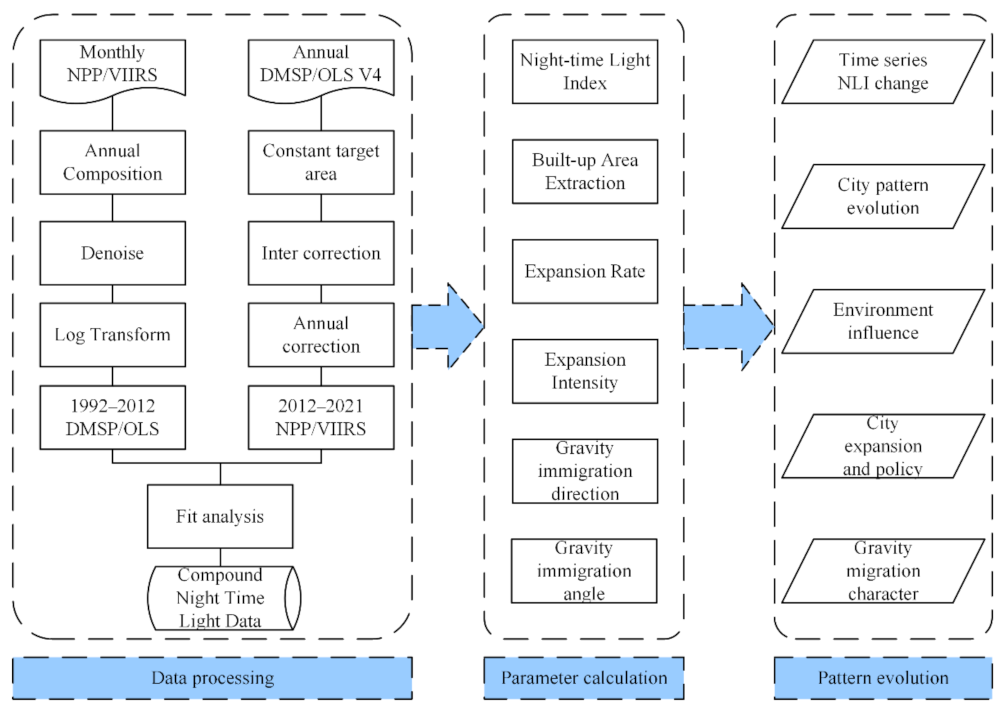

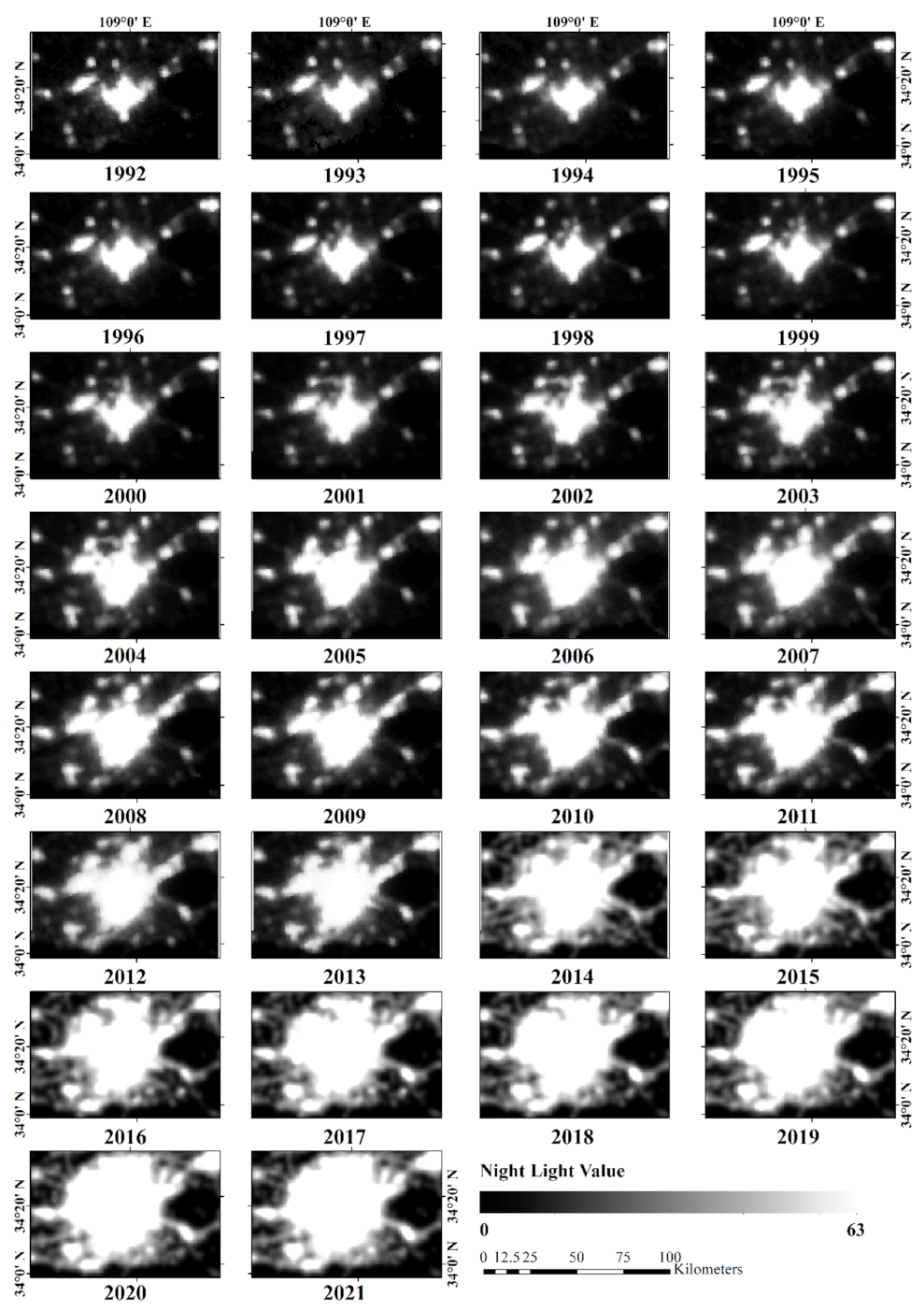
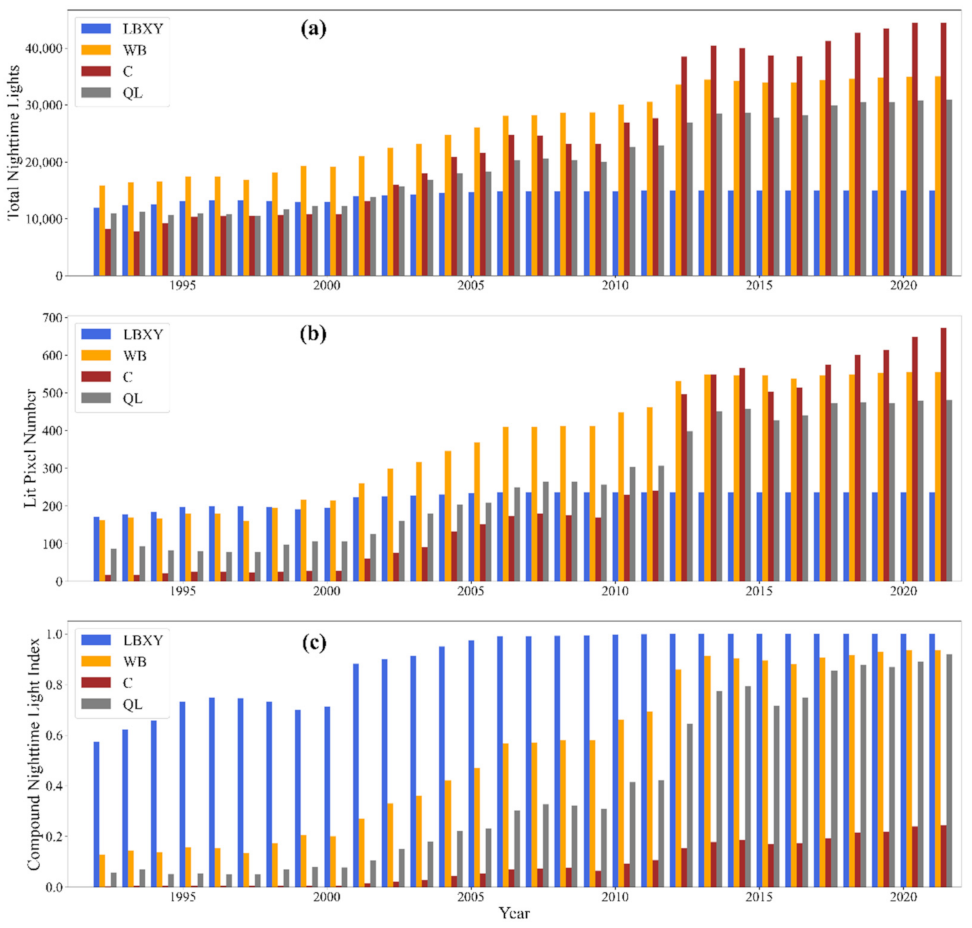
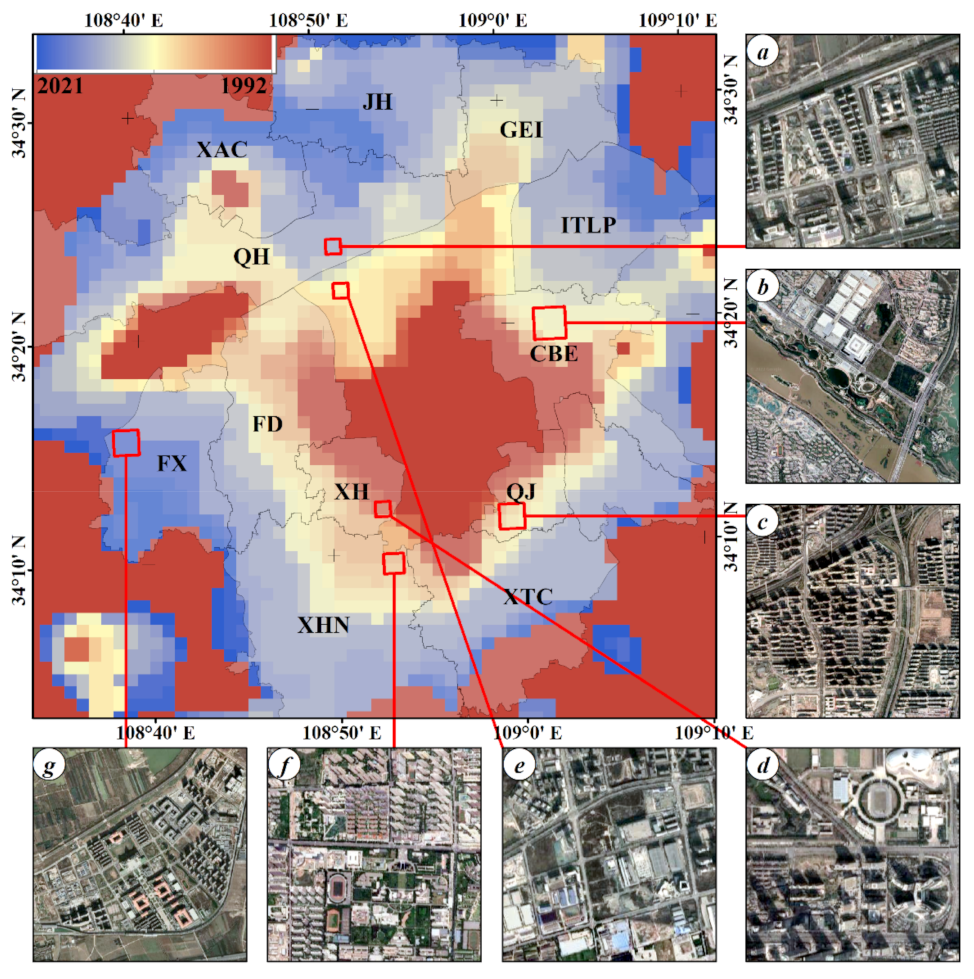

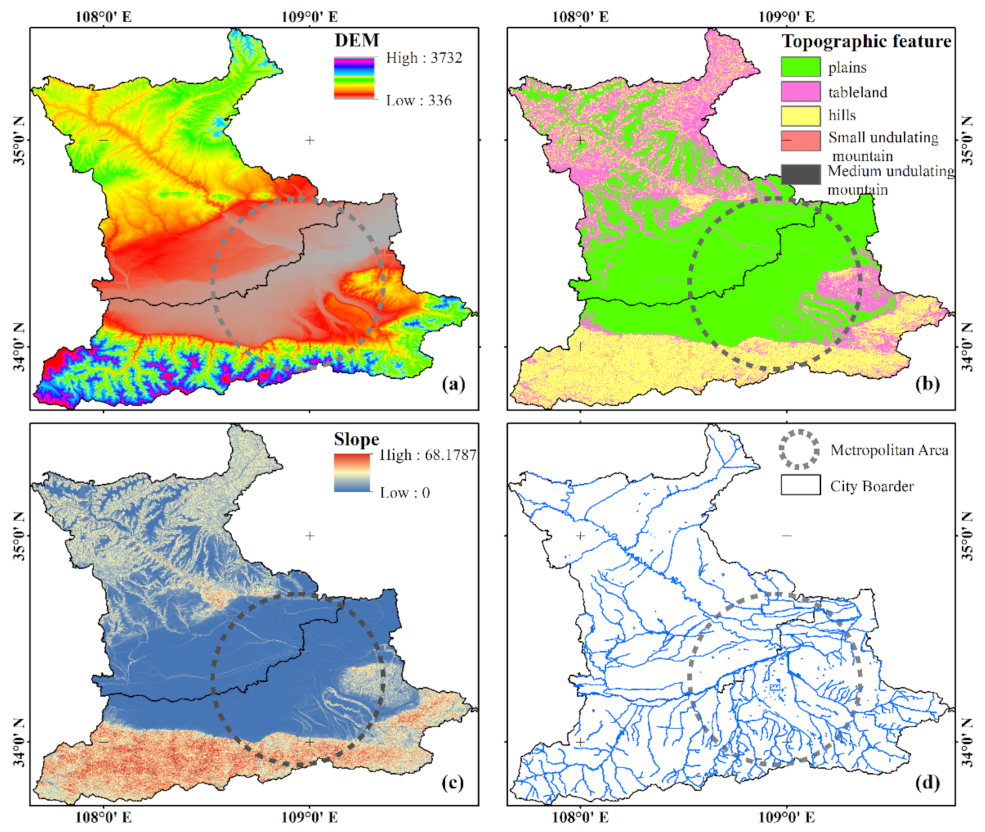
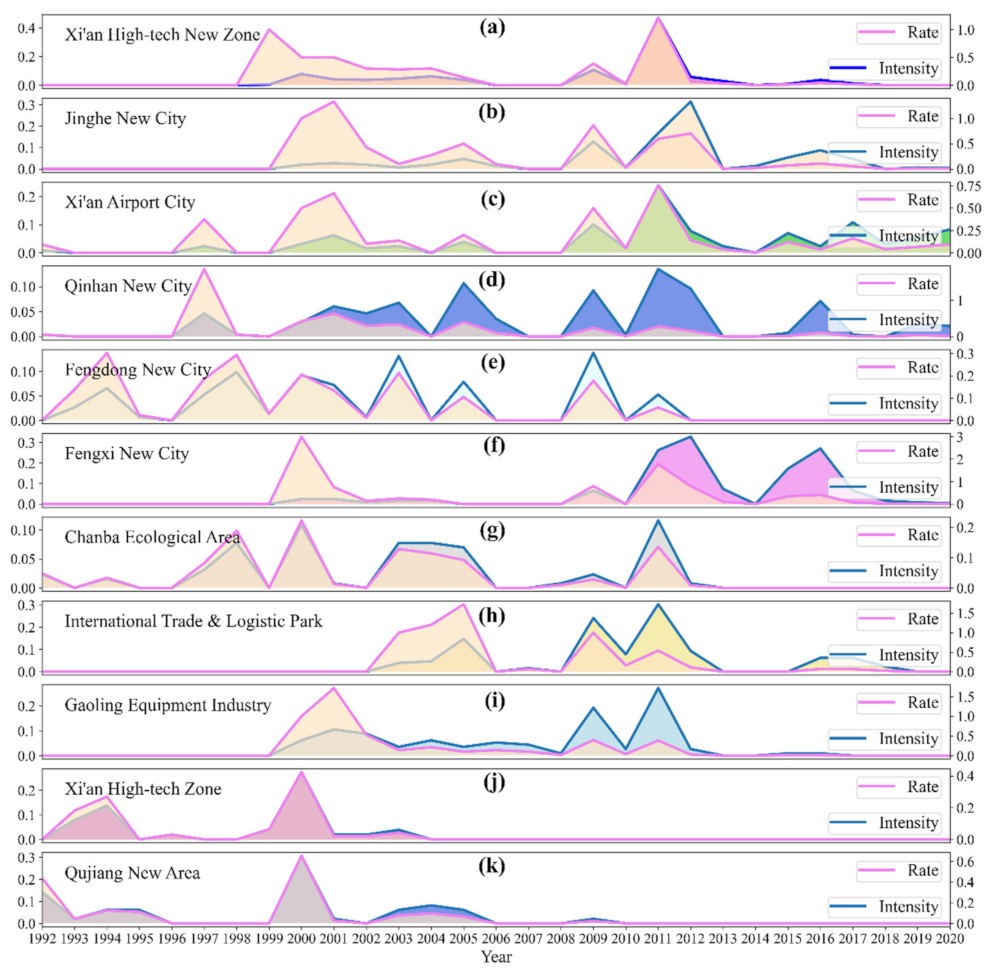
| Year | F10 | F12 | F14 | F15 | F16 | F18 | NPP |
|---|---|---|---|---|---|---|---|
| 1992 | F101992 | - | - | - | - | - | - |
| 1993 | F101993 | - | - | - | - | - | - |
| 1994 | F101994 | F121994 | - | - | - | - | - |
| 1995 | - | F121995 | - | - | - | - | - |
| 1996 | - | F121996 | - | - | - | - | - |
| 1997 | - | F121997 | F141997 | - | - | - | - |
| 1998 | - | F121998 | F141998 | - | - | - | - |
| 1999 | - | F121999 | F141999 | - | - | - | - |
| 2000 | - | - | F142000 | F152000 | - | - | - |
| 2001 | - | - | F142001 | F152001 | - | - | - |
| 2002 | - | - | F142002 | F152002 | - | - | - |
| 2003 | - | F142003 | F152003 | - | - | - | |
| 2004 | - | - | - | F152004 | F162004 | - | - |
| 2005 | - | - | - | F152005 | F162005 | - | - |
| 2006 | - | - | - | F152006 | F162006 | - | - |
| 2007 | - | - | - | F152007 | F162007 | - | - |
| 2008 | - | - | - | - | F162008 | - | - |
| 2009 | - | - | - | - | F162009 | - | - |
| 2010 | - | - | - | - | - | F182010 | - |
| 2011 | - | - | - | - | - | F182011 | - |
| 2012 | - | - | - | - | - | F182012 | SVDNB2012 |
| 2013 | - | - | - | - | - | F182013 | SVDNB2013 |
| 2014 | - | - | - | - | - | - | SVDNB2014 |
| 2015 | - | - | - | - | - | - | SVDNB2015 |
| 2016 | - | - | - | - | - | - | SVDNB2016 |
| 2017 | - | - | - | - | - | - | SVDNB2017 |
| 2018 | - | - | - | - | - | - | SVDNB2018 |
| 2019 | - | - | - | - | - | - | SVDNB2019 |
| 2020 | - | - | - | - | - | - | SVDNB2020 |
| 2021 | - | - | - | - | - | - | SVDNB2021 |
Publisher’s Note: MDPI stays neutral with regard to jurisdictional claims in published maps and institutional affiliations. |
© 2022 by the authors. Licensee MDPI, Basel, Switzerland. This article is an open access article distributed under the terms and conditions of the Creative Commons Attribution (CC BY) license (https://creativecommons.org/licenses/by/4.0/).
Share and Cite
Li, S.; Li, X.; Zhang, M. Spatial-Temporal Pattern Evolution of Xi’an Metropolitan Area Using DMSP/OLS and NPP/VIIRS Nighttime Light Data. Sustainability 2022, 14, 9747. https://doi.org/10.3390/su14159747
Li S, Li X, Zhang M. Spatial-Temporal Pattern Evolution of Xi’an Metropolitan Area Using DMSP/OLS and NPP/VIIRS Nighttime Light Data. Sustainability. 2022; 14(15):9747. https://doi.org/10.3390/su14159747
Chicago/Turabian StyleLi, Shangzhi, Xuxiang Li, and Meng Zhang. 2022. "Spatial-Temporal Pattern Evolution of Xi’an Metropolitan Area Using DMSP/OLS and NPP/VIIRS Nighttime Light Data" Sustainability 14, no. 15: 9747. https://doi.org/10.3390/su14159747
APA StyleLi, S., Li, X., & Zhang, M. (2022). Spatial-Temporal Pattern Evolution of Xi’an Metropolitan Area Using DMSP/OLS and NPP/VIIRS Nighttime Light Data. Sustainability, 14(15), 9747. https://doi.org/10.3390/su14159747







